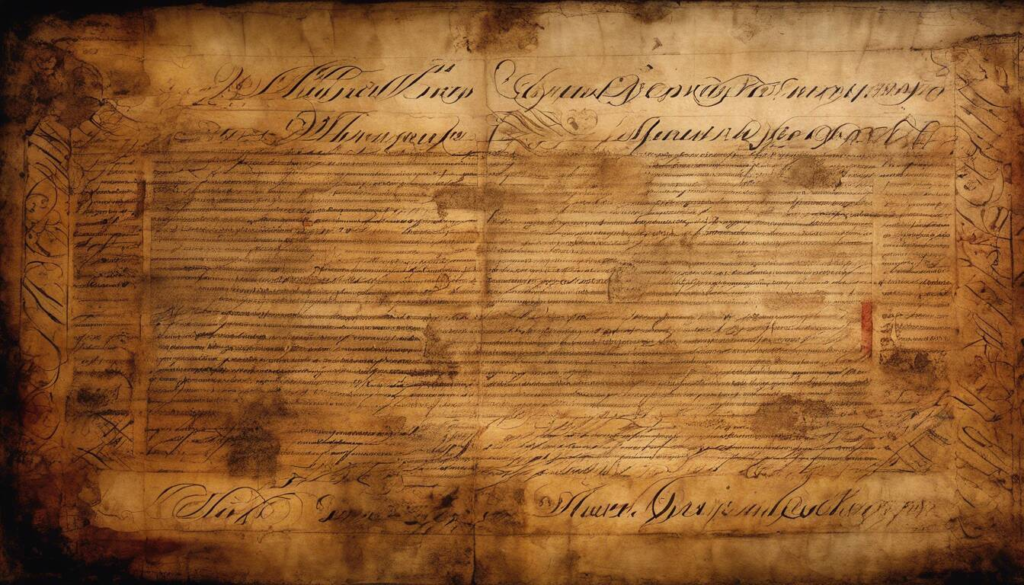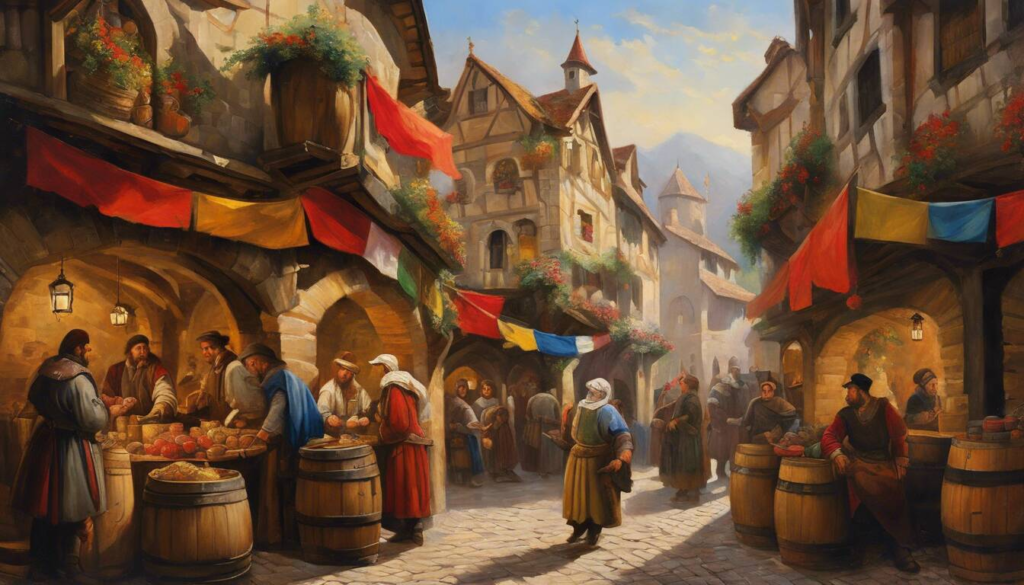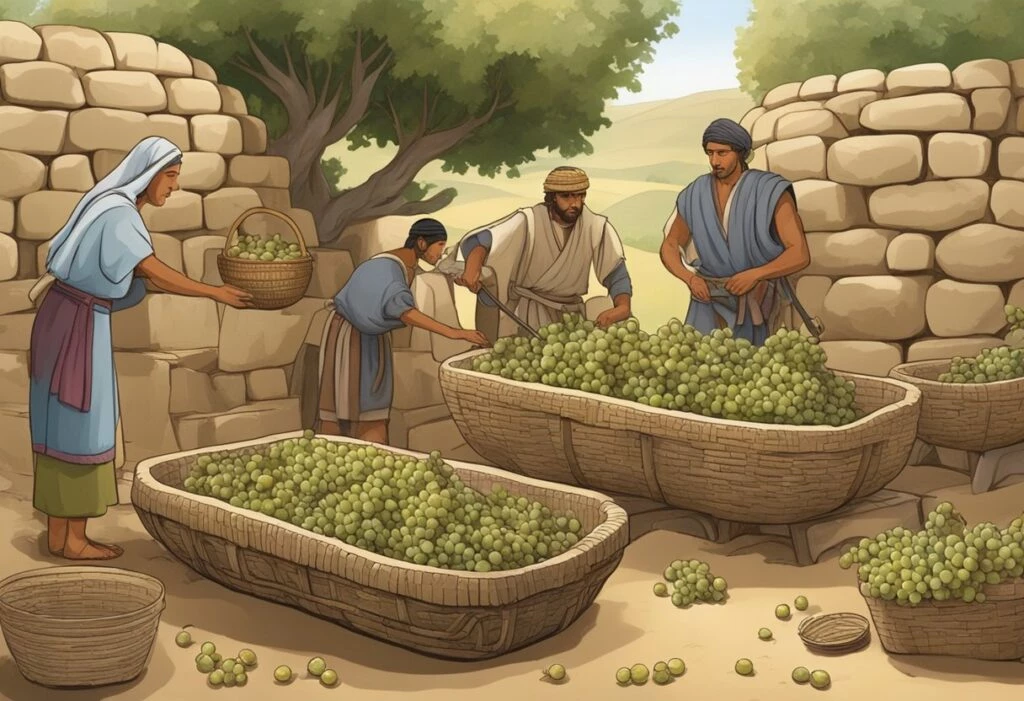The rules regarding wine during the Middle Ages were not casual matters. The Church, an authority of those times, set strict standards for its quality and use, especially as wine found a key place in religious rituals. Even more intriguing, monks weren’t just praying – they were making significant contributions to winemaking techniques, giving us a hint of the divine in every sip! As for the Roman Empire’s part, well… they didn’t stop at either boundaries or vineyards. Now, let’s take a closer look at these church rituals and Roman influences on winemaking.
Wine regulations in the Middle Ages often involved restrictions on production quantities, quality standards, and pricing set by local authorities or guilds. These regulations aimed to maintain order in the wine trade and prevent fraudulent practices, ensuring that wine was produced and distributed to meet certain standards of quality.

Church Regulations on Wine in the Middle Ages
During the Middle Ages, the church maintained its influential role in many aspects of society, including vine cultivation, winemaking, and regulating wine consumption. The Catholic Church recognized the importance of wine in religious ceremonies, particularly in the sacrament of Holy Communion. Consequently, this led to the establishment of strict guidelines to ensure the quality and purity of wine used in these sacred rituals.
The church imposed regulations on various aspects of winemaking—ranging from grape variety selection to winemaking processes—in order to uphold religious integrity. It was crucial for the church to ensure that the wine used in religious ceremonies met specific standards to maintain sanctity and reverence. As a result, these regulations significantly influenced the practice of viticulture during medieval times.
One notable example is the Benedictine monks, who were renowned for their contributions to viticulture. These monks took great care in cultivating vineyards and mastering winemaking techniques, applying their knowledge to produce wines for religious use as well as for trade. The dedication and expertise of monks like those from the Benedictine order, played a pivotal role in shaping winemaking practices under church regulations.
Moreover, monastic vineyards often enjoyed exemptions from certain regulations due to their religious significance. This allowed them a degree of autonomy in their winemaking activities within the framework set by the church’s guidelines. The influence of these monasteries extended beyond religious settings, as they became key players in advancing winemaking practices across Europe.
The overall conclusion is that the church’s regulations on wine during the Middle Ages underscored the integral role of wine in religious ceremonies and social life. The impact of these regulations was far-reaching, shaping winemaking traditions and fostering a deep connection between viticulture and religious practices.
As we journey through history and explore the evolution of wine culture, we now turn our gaze to an era that laid significant foundations for wine rules—the profound impact of the Roman Empire.
The Impact of the Roman Empire on Wine Rules
When considering the history of wine, it’s impossible to ignore the indelible mark left by the Roman Empire. It wasn’t just about conquering new lands; the Romans also brought with them advanced knowledge of grape cultivation and winemaking techniques. Their influence extended beyond simply growing grapes; they set up regulations for winemaking and instituted a classification system for vineyards.
The Roman Empire was recognized for establishing clear regulations for many aspects of life, including viticulture. Regarding vineyards, they implemented strict classifications to ensure a standard of quality and uniformity in grape cultivation. This became essential, allowing consumers to have confidence in the wine they were purchasing, knowing it met specific quality standards.
This marked the beginning of regulations concerning geographical origin, akin to today’s “appellations” or designated regions. Roman wines were classified based on their place of origin, laying the groundwork for what would eventually become the modern wine appellation system.
The Romans also significantly influenced trade and commerce related to wine. They developed efficient trade routes and introduced standardized measures and containers for transporting wine, expanding wine trade throughout their vast empire with their fortified roads making transportation easier.
The dissemination of grape cultivation techniques was one of the most enduring legacies of the Roman Empire. Through their conquests and colonization efforts, they introduced advanced methods of vineyard management and winemaking across different regions. Their meticulous care in selecting grape varieties suitable for specific climates and soils revolutionized viticulture practices in areas where grape cultivation had previously been minimal or less refined.
Their contributions set a standard for excellence in winemaking that endured long after their empire fell. Even today, we can see glimpses of their influence in renowned winemaking regions around the world.
The influence of the Roman Empire on wine rules and viticulture practices is evident in many aspects of our contemporary winemaking. Now that we’ve explored this rich historical legacy, let’s further examine how these ancient traditions continue to shape our approach to grape cultivation and winemaking today.
The Trade of Wine and the Role of Taxes

In the Middle Ages, wine trade was a significant economic activity, contributing to the wealth of local authorities and ruling elites. However, these transactions were far from straightforward. The production and distribution of wine were heavily regulated, and taxes played a pivotal role in shaping the pricing and availability of this precious commodity.
Local authorities and feudal lords imposed taxes on wine as a means to exert control over its trade. These taxes varied across regions and kingdoms, often forming a substantial portion of the rulers’ revenue. The imposition of tariffs and duties not only influenced the cost of wine but also dictated who could engage in the wine trade. This intricate web of regulations and taxes greatly impacted the accessibility and affordability of wine within medieval communities.
| Location | Tax Imposition | Effect on Wine Trade |
|---|---|---|
| England | Assize of Wine established in 12th century | Set standards for quality and pricing; regulated import and export |
| Various Regions | Varied tariffs and duties | Controlled distribution; generated revenue for rulers |
These regulations weren’t just about controlling trade but also about maintaining order within communities. By exerting authority over the wine trade, rulers ensured that the supply chain remained stable, thereby preventing potential disruptions that could affect social harmony.
Moreover, these regulations had a direct impact on consumers. They determined what kind of wine was available to different segments of society based on their financial means. The affluent could access finer wines with greater ease, whereas those with limited resources were bound by the constraints imposed by these taxes and regulations.
These systems ultimately defined not just what shapes ended up in glasses across Europe but also reinforced social class distinctions by making certain types of wines more accessible to some groups than others.
The implications went beyond financial considerations; they had far-reaching effects on social dynamics as well.
Critics may argue that these regulations restricted free trade and hindered fair access to this essential beverage. Although it can be debated that these regulations may have led to inequalities, it’s important to acknowledge that they conversely contributed to the survival and stability of viticulture during a period plagued by economic uncertainties.
The stringent taxation policies and regulatory measures governing wine trade in the Middle Ages profoundly impacted not just commerce but also society at large.
As we progress to unravel more aspects of medieval viticulture, let’s now turn our attention to exploring the craft behind producing wine in this era – a meticulous process that defined the quality and availability of this treasured elixir.
The Art of Wine Production and Quality Control
In medieval times, wine production was more of an art than a science. Winemakers relied on a combination of traditional methods passed down through generations and their own innovative techniques to produce high-quality wine.
Fermentation was the cornerstone of winemaking in the Middle Ages. Grapes were crushed and then left to ferment in large wooden or clay containers. This fermentation process was carefully monitored to ensure that the sugars in the grapes were converted into alcohol.
The storage conditions during fermentation were crucial. Winemakers had to be mindful of temperature, humidity, and light exposure to maintain optimal conditions for the yeast to do its work. It was truly a delicate balance between nature and human intervention.
Quality control was essential at every step of the winemaking process. Poor storage conditions, contamination, or irregular fermentation could ruin an entire batch of wine. To address this, innovative monitoring methods were employed to keep a watchful eye on every stage of production.
Quality Control Measures
- Monitoring Fermentation: Observing the bubbles formed during fermentation to gauge the progress and predict the sweetness or dryness of the final product.
- Storage Conditions: Checking the temperature and humidity levels to prevent spoilage and maintain consistent flavor profiles.
- Grapes Selection: Carefully selecting the best grapes for winemaking, as grape variety played a significant role in defining the quality of the resulting wine.
Every decision from grape selection to bottling was made with one goal in mind: producing a wine that met certain standards of quality.
Quality control meetings between vintners were not uncommon during this time as they discussed best practices and shared knowledge that had been gained through experience over many years.
It’s clear that creating wine in medieval times required a blend of expertise, innovation, and careful observation at every stage. Each batch was a unique experiment, grounded in centuries-old traditions yet open to new ideas and improvements.
Having explored the delicate dance between tradition and innovation in medieval wine production, it’s evident that it paved the way for the flourishing viticulture we witness today.
Insights into Grape Cultivation and Vineyards
In the Middle Ages, grape cultivation was a complex art. It wasn’t just about planting grapes; it involved understanding the land, observing the climate, and selecting suitable grape varieties. The success of winemaking depended on the quality of the grapes and required careful consideration guided by tradition and wisdom passed down through generations of winemakers.
Grape varieties played a crucial role in the cultivation process during medieval times. There were multiple cultivated grape varieties, each unique in its properties and suitability for different regions. Vineyards also varied greatly in size, influenced by factors such as the wealth of the owner and the purpose of the vineyard. When choosing a vineyard location, soil quality was critical as different grape varieties had preferences for specific soil types.
For instance, in regions with limestone soil like Burgundy, France, Pinot Noir and Chardonnay grapes flourished. On the other hand, areas with granite-based soil like parts of Spain were ideal for growing Tempranillo grapes.
Regulations concerning grape cultivation and wine production were prominent during medieval times. The Catholic Church held significant influence over winemaking practices at that time and implemented regulations to govern grape cultivation. Some might argue that these stringent regulations stifled innovation and hindered new approaches to winemaking. However, a standardized approach ensured consistency and quality across various regions, ultimately benefiting consumers who could rely on wine produced according to established standards.
Understanding these insights into grape cultivation and vineyards gives us a glimpse into the intricate world of winemaking during the Middle Ages—the careful selection of grape varieties, soil considerations, vineyard sizes, and regulatory frameworks that shaped viticulture during this era.
A Glimpse into the Social and Economic Impacts of Wine Regulations
The regulation of wine during the medieval period wasn’t simply an exercise in control; it had significant implications for social structure and economic prosperity. Let’s explore how these regulations influenced and shaped the society of that era.
Trade Relationships: Wine regulations dictated where wine could be produced, how it was distributed, and who was permitted to participate in the trade. This stringent guidance impacted international trade relationships, local economies, and even power dynamics between different regions and countries. The flow of wine became intertwined with diplomatic negotiations and served as a tool for fostering alliances or resolving conflicts. Restrictions on imports and exports often led to tension between territories, shaping the political landscape of medieval Europe.
Local Economies: By controlling aspects such as pricing, production methods, and distribution networks, wine regulations had a tangible impact on local economies. They influenced employment opportunities, income distribution, and infrastructure development. The proliferation of vineyards in certain regions was directly linked to economic growth, attracting laborers and craftsmen who contributed to the growth of towns and cities. Conversely, regions governed by restrictive wine laws often experienced stunted economic progress due to limited opportunities for commerce and innovation.
While the economic impact is clear, let’s not overlook its effects on social gatherings. Imagine a bustling medieval town fair or a banquet held by nobles—these were occasions where wine played a central role.
Social Gatherings: Wine regulations influenced the accessibility of wine during social events, shaping the nature of interactions among people from different walks of life. The availability of specific wines at such gatherings often signified social status or cultural affiliation. For instance, certain wines may have been reserved for nobility while others were more common among the masses. These distinctions not only reflected societal hierarchies but also impacted social cohesion and cultural exchange.
Impact on Religious Practices: Furthermore, considering the prominent role of religious institutions in viticulture during that time, these regulations had implications for religious practices as well. Monks and priests were often entrusted with producing sacramental wines, and their ability to adhere to regulatory requirements directly influenced religious ceremonies and rituals.
In essence, the strict governance surrounding wine production and trade permeated every facet of medieval life—shaping economic landscapes, defining social interactions, and even impacting religious observances. Examining these regulations offers valuable insight into the complexities of medieval society and the interconnectedness of its cultural and economic frameworks.
The intricate web of wine regulations in medieval times serves as a captivating gateway into understanding the intricate tapestry of societal structures and economic dynamics that defined that era.

